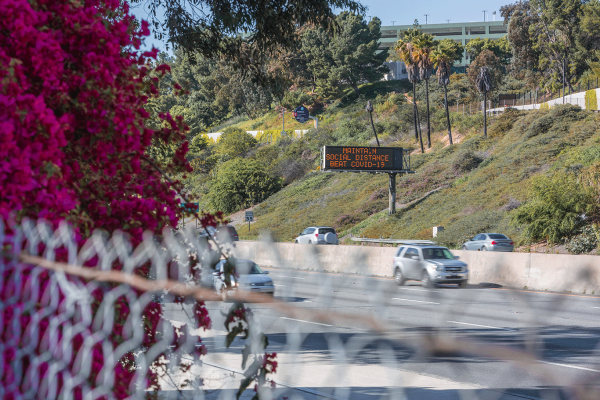For the Press: Transportation and COVID-19
The novel coronavirus has affected nearly every sector of public life, including transportation. Researchers at UCLA ITS are adapting to this rapidly evolving situation like everyone else. As we work on developing research on the effects of coronavirus and COVID-19 on mobility, we’ve started by compiling a list of the different areas of transportation that have been most affected, from road congestion to public transit use to travel by disadvantaged populations.

Electronic signage on the Hollywood Freeway urges LA residents to practice social distancing. (Credit: Jorge Villalba/istock)
Public Transit
The pandemic has dramatically accelerated a broader decline in public transit use across the nation. While the causes and scale are different, the current drop in transit ridership induced by the coronavirus comes after five years of falling transit patronage nationwide. UCLA ITS has studied this pressing issue in a number of areas, including Los Angeles, the San Francisco Bay Area, and California, and developed visualizations of ridership trends.
With social distancing measures and shelter-in-place orders, transit ridership has plunged much deeper recently, with Transit App, Moovit, and Google reporting 50 to 90 percent declines in transit use in major metropolitan areas. As UCLA ITS Director Brian D. Taylor recently noted, the virtues of public transit are precisely at odds with coping with the pandemic: transit is good at moving a lot of people in the same direction at the same time to and from dense activity centers, all of which go against the public health mandate not to move nor congregate.
However, public transit must stay open to allow those without other means of transportation to travel to essential jobs. And for those who stop taking transit, many may adjust to other means of travel and not return after the pandemic ends — for instance, during a much smaller travel disruption like Los Angeles’ “Carmageddon,” we found very little new use of public transit both during and after the freeway closures. The consequences of coronavirus for public transit will thus last long beyond the current crisis.
Past experience suggests that public transit use recovers slowly following epidemics. Public health officials expect that public concerns with crowding and disease transmission will persist for some time after a resumption of activities, so former transit users who can drive private vehicles may be more likely to eschew riding on transit. On the other hand, lower-income households, particularly those that have been hit hard economically by the shutdown, may find it harder to hang onto cars and may be forced to give them up in favor of riding public transit. As a result, we may find that public transit use will be slow to rebound in the near term, and that the user base may skew more lower-income than before.
Additional Resources
- What’s Behind Recent Transit Ridership Trends in the Bay Area? (2020)
- Falling Transit Ridership: California and Southern California (2018)
- Does Light Rail Reduce Traffic? The Case of the LA Expo Line (2018)
- Transit trends across California (forthcoming)
- Transit in the 2000s: Where Does It Stand and Where Is It Headed? (2018)
- “Ridership Visualization” dashboard on TransitWiki
Traffic Congestion
At the outset of the pandemic, traffic congestion underwent an extraordinary decline. Large cities once paralyzed by a glut of vehicles saw, for the first time in decades, wide-open roads during weekday rush hours. Congestion was almost non-existent, even in places where it is endemic. Many pernicious byproducts of congestion fell as well: Pollution was down, and so were collisions. Closing the economy had massive costs, but also offered some benefits: Less noise, cleaner air, and faster trips for essential workers and emergency vehicles still using the roads.
As predicted, however, this drop in congestion was short-lived. In cities throughout the U.S., traffic has returned to pre-pandemic levels. People did not stop driving during the pandemic because they had developed new travel habits. They stopped driving, for the most part, because they stopped going out (and those who did go out, like essential workers, were if anything more likely to drive when they did so). As cities reopened and people began traveling again, they resumed their old travel habits. And so a traveler getting on the 10 freeway in Los Angeles 20 months into the pandemic encounters the same sea of brakelights, and the same infuriating stop-and-go trip, she recalls from pre-pandemic L.A.
Nevertheless, it is too early to say that the pandemic will have no longer-term effects on travel. The pandemic caused millions of people to shift to work at home. As COVID-19 restrictions ease, some employers may decide to continue offering a work-from-home option. Employers may be unlikely to let workers stay home every day (and many workers may not want to stay home every day) but a larger share of the workforce might find itself with the option of a hybrid work week, where at least a few days every two weeks can involve telecommuting. Were this to occur, and endure, it would mark a large shift in American travel behavior. The shift, however, would be in the mix of modes for commuting; it would probably not result in a change in congestion. The Fundamental Law of Road Congestion would still hold: In a busy metropolitan area, empty road space will be filled. Some of that road space, in fact, will likely be filled by the same people choosing to work from home. Telecommuting, after all, means not going to work; it does not mean never leaving your house. Plenty of people who work from home drive around during the day.
A second lasting change to traffic might come from a shift to online shopping. A growing number of people shopped online before the pandemic, but many more do so now. If this elevated online shopping persists, it will result in a shift of personal travel (trips to and from stores) to commercial deliveries, and converts many trips from unpaid domestic work (a mother runs out to buy groceries) to paid formal labor (a delivery service picks up the groceries and drives them to the house). These changes are substantial, but may not reduce total vehicle traffic much, although they could shift the type and timing of traffic.
The pandemic offered a brief hiatus from traffic congestion. But the costs of that hiatus were immense. Congestion fell because the economy contracted, and that contraction threw millions of people out of work and injected tremendous stress and precarity into their lives. The transportation lesson of the pandemic is thus not that we should have less economic activity, but that we should seek to sever the link between a prosperous economy and clogged roads. UCLA has provided past guidance on how to do this, including how and if it affects accessibility, ways to mitigate congestion including congestion pricing, and how congestion pricing can be effective while maintaining equity.
Additional Resources
- Longer View: The Fairness of Congestion Pricing (2019)
- Does traffic congestion influence the location of new business establishments? An analysis of the San Francisco Bay Area (2018)
- Is traffic congestion overrated? Examining the highly variable effects of congestion on travel and accessibility (2017)
- THE ACCESS ALMANAC: Traffic Congestion Is Counter-Intuitive, and Fixable (2017)
New Mobility
Fragmentary evidence suggests that new transportation services that focus on moving people, like Lyft and Uber, have witnessed substantial declines in patronage, while those focused on small goods deliveries have seen sharp spikes in demand. As with public transit, demand for ridehail services may be slow to rebound after quarantine restrictions are eased, while tens of millions of customers newly accustomed to home delivery may continue to demand such services in the months and years ahead.
As personal travel has plummeted across all modes of transportation, new mobility companies are struggling to find alternative sources of revenue to keep their businesses running. Many new mobility companies are not profitable — even under normal circumstances — and rely on venture capital investment and the depreciation of millions of privately-owned vehicles to exist. In light of the decline in user travel and the country’s economic downtown, venture capital investment in new mobility companies may subside. As a response to this decrease in funds, many companies will have to reduce their operations costs to save money, including laying off employees.
On the flipside, the exponential rise in unemployment in the United States may push more workers to these new mobility companies for much-needed income as part of the gig economy. As noted above, more Americans are relying on shopping and delivery services that limit their personal contact, but this growth increases risks for workers. Without a proper internal structure in place for drivers at many companies, these workers — many of whom are already struggling financially — may see increasingly precarious wages and working conditions.
In addition to pivoting their operations, new mobility companies may adjust how they invest their research and development budgets. In light of the need to physically distance from other people, companies may start to invest more in autonomous vehicle (AV) development. And companies already bringing AVs to market, like Waymo, may consider adding delivery of goods to their capabilities platforms as a way to bring in more revenue.
Additional Resources
- Sharing Mobility Data for Planning and Policy Research (2020)
- Disruptive Transportation: The Adoption, Utilization, and Impacts of Ride-Hailing in the United States (2019)
- Ridehail Revolution: Ridehail Travel and Equity in Los Angeles (2018)
- Ridesourcing’s Impact and Role in Urban Transportation (2017)
Finance
To consider the impact of COVID-19 on transportation finance, it’s important to know from where the public sector gets revenues for transportation and where and how they spend it.
Consider the case of public transit. Most transit expenditures fall into either capital costs (e.g. buying land, engineering, construction, buses, and trains) or operating costs (e.g. labor, pensions, health benefits, fuel, electricity). Transit is a public service that depends on federal, state, and local money for far more than it does on the fares people pay. In fact, fares do not cover capital costs and cover between 10 percent and half of the operating costs. A large portion of the revenue transit agencies receive at the state and local level comes from sales taxes. During safer-at-home orders, sales tax revenues have dramatically declined because stores and other businesses are closed. In the coming years, government officials may be more reluctant to push forward new ballot initiatives for sales taxes at a time that’s seeing record rates of unemployment.
To recover from a loss in revenue, in the short term, agencies can slow down or temporarily stop some of their capital projects — like building subway line extensions — but they must continue their daily operations. These types of costs require more federal, state, and local operating support because fare revenue will be lower than usual. Systems can cut costs slightly by reducing service a bit because demand has declined.
Other potential short-term solutions for transit agencies include reallocating money that they have reserved for capital costs towards operating costs. The agencies can slow down or cancel capital projects, construction of new lines and purchasing of new equipment, but these delays will not prove enough down the road. Another option is for the agencies to request longer time periods during which to pay bondholders the money that they have borrowed against future sales tax revenue. But this is also not enough long term. The agencies can not also look to fare increases as a solution since the riders include large numbers of low-income citizens, many of whom have lost their jobs due to the closing of businesses.
Ultimately, the only option is government support and perhaps, at some point, additional contributions in the form of charitable donations or employer support by purchasing transit passes for their employees in much larger numbers. But, there is no avoiding the burden this will place on taxpayers.
Additional Resources
- Do more EVs mean less transportation funding? Not so, says new study (2019)
- An Assessment of Performance Measures in the Transportation Development Act (2019)
- Arguing over Transportation Sales Taxes: An Analysis of Equity Debates in Transportation Ballot Measures (2018)
- From Fuel Taxes to Mileage Fees (2017)
- Local Option Transportation Taxes: Devolution as Revolution (2017)
Access to Opportunities
Even with so many Americans heeding government orders to stay at home, a disproportionate number of lower-income people are forced to take a higher risk when it comes to their health and safety.
While public transit ridership has dropped around the country, for many it is still their only option for essential travel. If car ownership or car repairs are not financially possible, those with limited financial resources have to set aside public health recommendations to sustain themselves. As Evelyn Blumenberg, professor of urban planning and director of the Lewis Center for Regional Policy Studies said: “For low-income workers who have to take transit, they’re in a confined place, in close proximity to other people. Their problems are compounded. They have no other option.”
Aside from limiting congregating on public transportation, having access to a car has multiple benefits during this pandemic. When making grocery store trips, those individuals with cars are more able to stock up on weeks worth of food and groceries. Those without a car may be limited by what they’re able to carry on their selected mode of travel (e.g., transit, walking, or biking). During these times, the simple act of making multiple trips out of one’s home can significantly increase your risk of falling ill. In car-dominant cultures like Los Angeles many services rely on personal vehicles, including drive-up testing sites. Of the two dozen COVID-19 testing sites in Los Angeles County, only a handful offer walk-up services.
Furthermore, a majority of low-wage workers are performing essential services during this period, putting themselves at risk delivering food and goods, interfacing with multiple customers. Their transportation options moving forward, given the deep, looming economic downturn are particularly precarious, especially for those struggling to afford cars at a time when work is increasingly scarce.
Additional Resources
- Carless in California: What the Carless Can Tell Us About Shifting Behaviors and Improving Mobility (2019)
- Residential Location, and the Changing Commute in the United States (2019)
- The Poverty of the Carless: Toward Universal Auto Access (2019)
- Car-deficit households: determinants and implications for household travel in the U.S. (2018)
For Reporters on Deadline:
Claudia Bustamante, Communications Manager
424-259-5486 / claudb@ucla.edu






